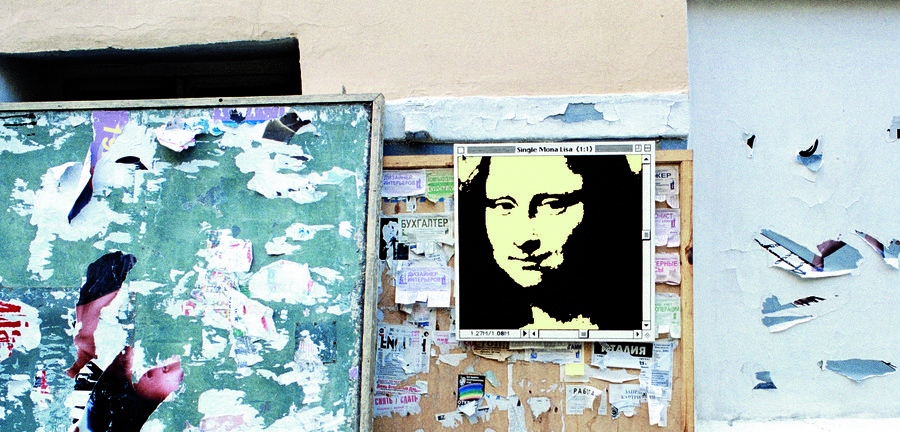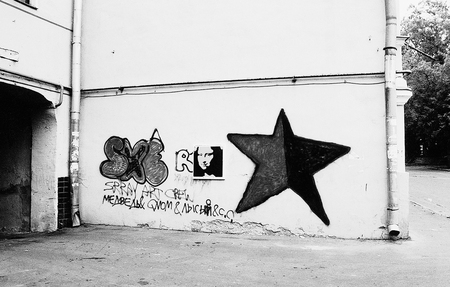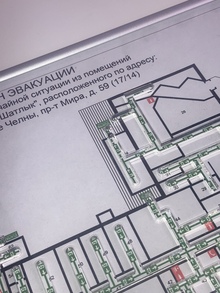
Mona Lisa Travels. V. Underway with Mona Lisa
CHRISTOPH ZUSCHLAG
UNDERWAY WITH MONA LISA

When Leonardo’s Mona Lisa was exhibited for three months in 1974, first in the Tokyo National Museum and then in the Pushkin Museum in Moscow, this was a sensation. More than two million people were willing to wait for hours in order to catch a glimpse of the most famous picture in European art history. Approximately 25 years later, Mona Lisa has again been sighted in Moscow, but this time she seems to travel unannounced: no security measures, no lines of people, no media circus. Sick and tired of always being gawked at, Mona Lisa has left the museum and is exploring everyday Russian life all on her own. In the process, she doesn’t remain for long at any one place but suddenly pops up, like a submarine, on some street or other, on Red Square, on a billboard, before a monument, on a golf course or at the entrance to a church on the outskirts of town — and at the next moment vanishes again.
Something drives Mona Lisa. Or someone.

From the series Mona Lisa Goes Russia: Village in Kaluga region, 1998.
L-Print, 120×150 cm
George Pusenkoff, born in 1953 in Krasnopolje, Belorussia, and a visitor to the Mona Lisa presentation at the Pushkin Museum, studied computer sciences and art in Moscow. There he received important impulses from the non-conformist avant-garde around Ilya Kabakov and Erik Bulatov. In 1990, Pusenkoff emigrated with his family to Cologne, where he has since lived and worked, interrupted by regular visits to Moscow. Pusenkoff has made a name for himself in the East and the West with a kind of painting that combines quotation and paraphrase from the pictorial fund of art history with an innovative technique utilizing Internet and computer, thus reflecting on questions of pictorial creation, of perception and of the nature of the original in a medial age.
Pusenkoff’s art is based on the conviction that a truly contemporary painting and aesthetic must employ the new technological possibilities. The symbol of the communication age and the digital era is the computer. In recent decades it has permeated all areas of our society and thereby altered, as well, our perception of and our way of dealing with images.
Pusenkoff’s Single Mona Lisa (Yellow) stands at the center of a conceptual-photographic work in progress with which Pusenkoff has been engaged since 1998 and which is published in this volume for the first time. This book can only document a small selection from the hundreds of motifs, to which countless shots are added every year. The publication itself is thus a constituent part of an ongoing process.
The concept of Pusenkoff’s Mona Lisa Goes Russia can be described as follows: Outfitted with the Single Mona Lisa (Yellow), a middle-format camera and a supply of color film, the artist wanders throughout his native Russia — possibly in the future through other countries, cities and provinces, as well — in order to photograph his picture in the most diverse urban settings and landscapes, public and private scenes.
With his picture Pusenkoff marks locations and situations and captures them photographically. He documents and examines his country and at the same time distances it for the brief duration of the photographic act.
Sotchi. Black Sea, 1998. L-Print, 40×50 cm
Pusenkoff’s photographs are snapshots of everyday life in Russia, much like a reportage, yet at the same time, through the «alien element» of the painting, they seem like surrealistic scenes. Their perception through the viewer oscillates continuously between these two poles. Pusenkoff’s work thus proves itself to be, not least of all, a subversive, ironic, tongue-in-cheek commentary on our way of dealing with pictures.
Every photograph tells an anecdote, a story, but all the stories contain foreign words, as it were. There is a difference whether we are familiar with the habits of Russian life or not, whether we can read Cyrillic characters or not.
Many situations seem familiar to someone who has traveled in Russia: for example, the woman who sells garishly colored towels at the side of the road (whereby one of them bears the caption «Mona Lisa»), the market scene or the dacha idyll. In some pictures we see Cyrillic letters: somewhere, in a tiny village, Mona Lisa fits precisely into the dilapidated information box normally reserved for essential public notices; the poster on a wall promises an entertaining evening; the long luxury car is parked before the Premier Gambling Casino in St. Petersburg, into whose interior spaces we are led by further photographs.
Contemporary history is present in other pictures: the ship Aurora, for example, lying in anchor in St. Petersburg, gave the secret signal for the start of the October Revolution in 1917; the Lenin Monument; Vera Muchina’s monument to The Worker and the Kolkhoz Woman which in 1937, at the Paris World’s Fair, squarely defied the pavilion representing Nazi Germany; and finally, in a photo taken on September 11, 2001, in a private Moscow apartment, the television image of the flame-shrouded World Trade Center, which has burned itself into collective memory.
In an entire series of photos, Pusenkoff creates proximities between his Mona Lisa and Russian art-works.
In the Moscow atelier of Natalia Nesterova, Mona Lisa peeps out from behind a large picture by the well-known painter; in the National Russian Museum in St. Petersburg, Mona Lisa stands on an easel before a dramatic shipwreck scene by Iwan K. Aivazovsky, in the central aisle of the hall of icons and behind marble sculptures in the staircase; in the depot we see her before pictures of the 19th century, alongside the portrait of a sailor by Vladimir J. Tatlin and between works of Socialist Realism. Naturally, icons repeatedly play a role. On a blue-tinted church in the suburb of Moscow, Mona Lisa hangs outside on the entrance door below and between icons. Another picture, photographed in a tiny village, shows Mona Lisa in the corner which contains the household altar, hanging brashly along-side an icon of Christ — icon alongside icon. In this way Pusenkoff slips his picture into art history, determining through dialogue with tradition his own historical place as a contemporary artist. Finally, he brings Mona Lisa back to that building where it had its premiere on Russian soil a quarter-century ago: the Pushkin Museum.


From the series Mona Lisa Goes Russia. Left: Village of Kaftino, 1998, L-Print, 40×50 cm. Right: Moscow. Kolpachnij per., 1998. L-Print, 40×50 cm
There are photographs which show poverty and social misery, like homeless people at a bus-stop in the city of Orechovo-Zuevo and in a St. Petersburg subway station. And there are photographs which bear witness to prosperity, luxury and pleasure, like the casino scenes already referred to, a rock concert in Moscow, and the beach scene in Sotchi on the Black Sea. But Pusenkoff’s view of his Russian homeland is neither idealizing and romantically transfiguring nor socially critical; far more, it is the sober view of the chronicler and, above all, that of the artist who sees formal-aesthetic qualities.
Indeed, the photographs are composed, like paintings, in an entirely classical manner. In many examples, Pusenkoff works with the means of symmetry, for instance. He consciously employs stylistic means like reflections and light-shadow effects. In virtuoso manner he brings formal and color contrasts into the picture: for example, through hanging Mona Lisa on a fence on Moscow’s Yauzski Boulevard alongside two round street signs and a triangular one; on a putting green near Moscow, he lets the black-and-yellow Mona Lisa pick up the coloration of signs leading into the depth of the picture with notations of distance; the intensely colored scene in Sotchi is breathtakingly beautiful, as Pusenkoff inserts the Mona Lisa into a harmonious network of vertical, diagonal and horizontal pictorial axes.
In many pictorial inventions there speaks a pronounced sense of humor and irony. In Valentinovka, a suburb of Moscow, Pusenkoff sets Mona Lisa onto the outhouse toilet of a dacha, and in the city of Drezna onto the gynecological chair of the City Hospital. During shooting in the Moscow suburb of Archangelskoe, an elephant swings the painting in his trunk — certainly not a risk-free maneuver.
From the series Mona Lisa Goes Russia. Left: In the depot of the State Russian Museum with a painting by Vladimir Tatlin, 2001. Center: Icon corner, 1998. Right: Archangelskoe. Elephant, 2001
Witty, too, the different reactions of people. While many pose proudly before the camera, others remain uninvolved and motionless; while many regard the painting with curiosity, others take absolutely no notice of it. Even the directions and movements of the eyes within the pictorial scenes and among the protagonists (including Mona Lisa) and viewers tell an endless number of stories.
Pusenkoff’s Mona Lisa project brings East and West, painting and photography, art and everyday life into a tension-filled, aesthetically complex dialogue. The artist stages something, without his work being attributable to the genre of staged photography, and he documents without one’s being tempted to speak of documentary photography.
In the film Amélie from Montmartre the heroine dupes her father, who lives in a narrow-minded, petit- bourgeois idyll, by sending his garden gnome on a journey. From all over the world the father receives photographs which show the garden gnome alongside all sorts of famous buildings. In the end the father packs his suitcase in order to depart himself for distant places. Perhaps George Pusenkoff’s Mona Lisa project wishes to be precisely that: a catalyst.



